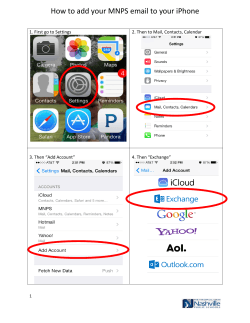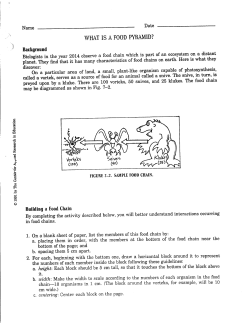
Approaching the quantum limit for metal nanoparticle plasmonics.
APPROACHING THE QUANTUM LIMIT FOR METAL NANOPARTICLE PLASMONICS Emily Townsend, Alex Debrecht and Garnett W. Bryant Quantum Measurement Division and the Joint Quantum Institute National Institute of Standards and Technology, Gaithersburg, MD University of Maryland, College Park, MD Quantum plasmonics • Understanding metal nanoparticles and nanoantennas: small sizes and small gaps … Tunneling, charge spillout and nonlocal response • Quantum nanoscale communication and single plasmons … coherent excitation transport, quantum optics • Hybrid structures … classical or quantized plasmons Nanohybrids: Classical or Quantum Different models for nanohybrids •Quantum dots (QD) as classical dipoles with classical metallic nanoparticles (MNP) …enhancement and quenching •QD as a two-level quantum emitter with classical MNPs … Nonlinear Fano effect, induced transparency, bistability … Govorov et al, Sadeghi et al, Artuso, Bryant, et al, … •QD as a two-level quantum emitter and MNPs with quantized plasmons … No bistability, noise effects, correct inclusion of Purcell effect … Near-field quantization: mode quantization as in a cavity … Near-field quantization: spectrum of local oscillators Matter point of view: approaching the quantum limit for MNPs Size quantization, quantized matter modes and quantized fields Matter point of view Finding the plasmons •Challenging many “few-body” problem with confinement effects, quantization •Single-particle vs collective (plasmons) or mixed? •Size dependence of excitation energies and response •Spatial character of resonance charge densities How? •Density functional theory … MNPs and dimers: Nordlander et al., Aizpurua, Borisov, et al., ET and GWB , … … 1D surface atom chains: Gao et al., Ruud et al., … … Linear molecules, CNT, etc., …: Jacob et al., Aiken, Schatz, et al, Garcia de Abajo et al., … •Exact approaches: Luttinger theory •Exact approaches: finite 1D chains … Short chains (<15 atoms): full spectrum … Long chains: selected energy ranges What can be learned about plasmons in small systems? •Time-dependent density functional theory (TDDFT) … Time dependent response or response function •Size quantization … 100-600 electron MNPs •Collective or single-particle response •Characterizing modes: “sloshing” and “inversion” •Exact approaches: short 1D chains, full spectrum Size quantization: density functional theory Spherical Metal Nanoparticles DFT ground state • Spherical Au nanoparticles • Jellium model • 100-600 valence electrons x (a.u.) 1.47 nm = 27.8 ao Time Dependent Density Functional Theory Ground State DFT… find occupied Kohn-Sham orbitals Time Dependent DFT Frequency response from instantaneous impulse Simulation time defines peak widths Drive on-resonance to characterize resonances Size quantization: 100-600 electron MNPs Townsend and Bryant, Nano Lett. 12, 429 (2012) Classical surface plasmons and quantum core plasmons Small spherical MNPs (~ 100 electrons) •Discrete modes •Excitations: DL = ±1 •Many-electron collective response or single-particle response •Charge oscillations: surface, core or both? Transition to classical surface plasmons (300-600 electrons) Classical Surface Plasmon E Surface charge oscillations Quantum Core Plasmon E Quantum core plasmon Core charge oscillation with weak surface oscillation Robust solutions…dependence on simulation size Rsim Surface plasmon Mixed plasmon Core plasmon Dependence on MNP size 100 electron MNP •Surface plasmon (the collective response?) becomes dominant for 600 e MNPs •Core plasmon and mixed plasmons much weaker •Width of main peaks defines surface plasmon width? •Implication for quantization model … Single mode or multimode? 600 electron MNP Collective or single-particle? Time dependent overlaps between the evolving KohnSham orbitals and the t=0 (ie ground state) Kohn-Sham orbitals •Diagonal overlaps … change in level occupation •Off diagonal overlaps … transitions with DL = ±1 •Which are single-particle or collective •Linear or non-linear? •TDDFT or response function? Collective or single-particle? Surface plasmon: 100e MNP 4 classes of transitions •Collective … Filled to empty … Filled to filled … Empty to empty •Single-particle Fermi level w/wsp Collective or single-particle? DE 0.9wsp Characterizing modes: “sloshing” and “inversion” •Problem: modes are mixed •What characterizes plasmonic response: “sloshing” •What characterizes single-particle component: “inversion” •Change in shell occupation •Time-dependence and Fourier (spectral) response Frequency content of each resonance: sloshing vs inversion Townsend and Bryant, J. of Optics 16, 114002 (2014) Temporal response: shell occupation for 100 electron MNPs Surface plasmon - Fermi level Ef is in the 2f shell - Emptying shells (blue) - Filling shells (red) For core and surface plasmons, temporal response of shell occupations shows Sloshing • Charge oscillating between filled shells just below the Fermi level Ef and empty shells just above Ef • Plasmonic component, stronger for surface plasmons Inversion • Charge continuously emptying from filled shells far below Ef to empty shells far above Ef • Single-particle transitions, stronger for core plasmons Quantum core plasmon Where in the MNP are these transitions? Surface plasmon Fermi level Quantum core plasmon occ to occ unocc to unocc occ to low unocc occ to hi unocc occ to occ unocc to unocc occ to low unocc occ to hi unocc Density functional theory: what is missing? •Optically driven states…no dark resonances •No correlation effects in charge densities •Quantized excitations ? •Fermions or bosons? Use exact approach for simple 1D chain models to investigate these effects Finite 1D chain: simple toy model 1D plasmons: linear molecules, atomic chains on surfaces, P dopants in Si • Coulomb-coupled, half-filled band of electrons: 1 spinless electron per 2 sites • Kinetic energy: nearest-neighbor hopping t i Z • Atom-electron coupling: Z = ne/nsite 𝑉𝑛𝑢𝑐 (𝑖) = − 𝑗 𝑛𝑢𝑐 𝑍/(|𝑖 − 𝑗| + 𝑛𝑢𝑐) • Electron-electron interaction: 𝑉𝑒𝑒 (𝑖, 𝑗) = 𝑒𝑒 /(|𝑖 − 𝑗| + 𝑒𝑒 ) • Charge neutrality: 𝑛𝑢𝑐 = 𝑒𝑒 • Applied field along the chain axis: 𝐸(𝑖 − 𝑖𝑚𝑖𝑑 ) Small, linear 1D chains: dependence on Coulomb coupling 𝑒𝑒 Full spectrum … 8 sites, 70 states … charge neutral … bounded spectrum Two types(?) of states … weak dependence on strength (single particle excitations ?) … stronger increase in excitation energy (plasmonic ?) Low energy Higher energy Small, linear 1D chains: dependence on Coulomb coupling 𝑒𝑒 Interaction Small, linear 1D chains: dependence on Coulomb coupling 𝑒𝑒 TDDFT Jacob, et al. Small, linear 1D chains: dependence on Coulomb coupling 𝑒𝑒 Small, linear 1D chains: dependence on Coulomb coupling 𝑒𝑒 Small, linear 1D chains: length dependence Full spectrum … 12 sites, 924 states … charge neutral Length dependence … 10 times denser spectrum … similar dependence on ee-interaction … similar length scaling with and without interaction Low energy Higher energy Small, linear 1D chains: bright or dark excitations? Full spectrum Low energy Bright + dark Bright only … dark excitations: dipole-forbidden by parity or multi-excitations … 8 sites: 13% (no interaction), 28% (with interaction) are bright … 12 sites: <2% (no interaction), 27% (with interaction) are bright Small, linear 1D chains: where are the plasmons? what makes a plasmon…smoking gun? Small, linear 1D chains: where are the plasmons? what makes a plasmon…smoking gun? Small, linear 1D chains: where are the plasmons? what makes a plasmon…smoking gun? Linear 1D chains: what are the plasmons? Speculation … higher energy, multielectron excitations … Coulomb induced transition dipole moments … resonant response: no explicit excitation with clear spatial characteristics What next? … driven states … smoking guns for plasmons … longer chains: do plasmons clearly appear? … excitations: bosonic, fermionic or … … nonlinear effects … short vs long range What can be learned about plasmons in small systems? A matter point of view •Time-dependent density functional theory (TDDFT) … Time dependent response or response function •Size quantization … 100-600 electron MNPs •Collective or single-particle response •Characterizing modes: “sloshing” and “inversion” •Exact approaches: short 1D chains, full spectrum Small, linear 1D chains: dependence on interaction with atoms Charge neutral … 8 sites, 70 states … similar spectra for each type of atom-electron coupling … similar trends No atom interaction Fixed atom interaction
© Copyright 2025











